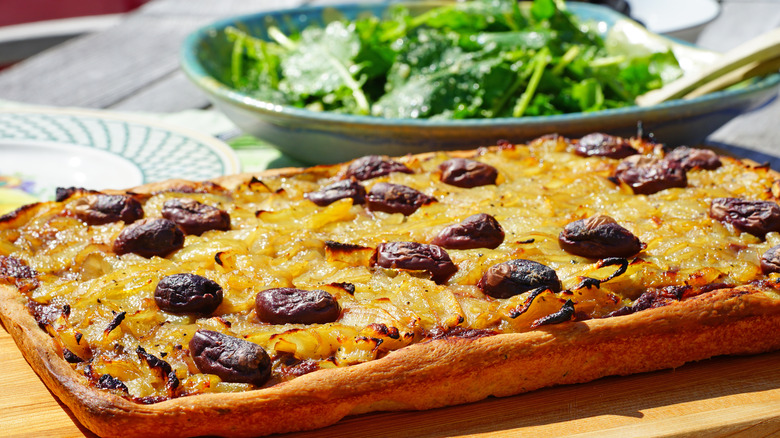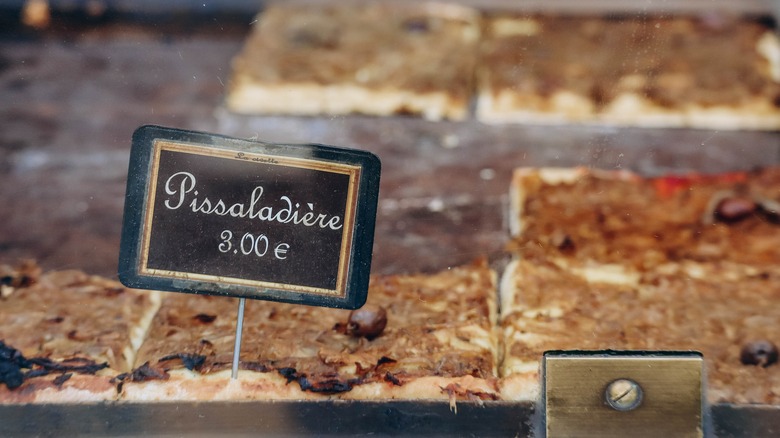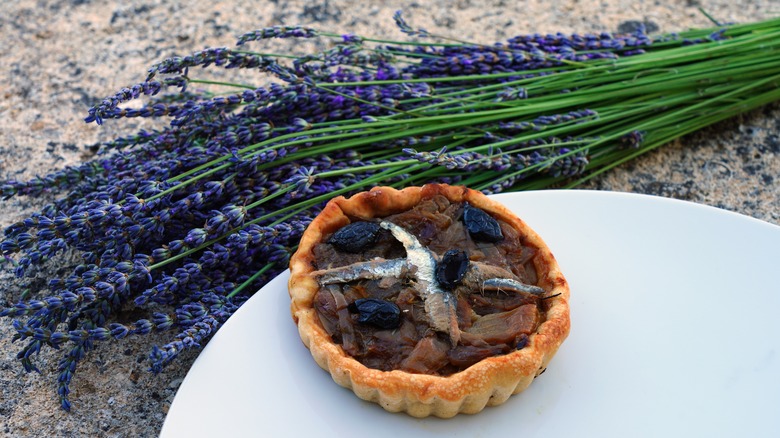Pissaladière Is The French Pizza Style You Need To Try
If there is a single food that the whole world collectively loves, it just might be pizza. While it's translated in dozens of different ways on all corners of the globe, the combination of a chewy base (usually made of dough) topped with warm, melty toppings (often including cheese — but not always) seems to be universally adored. In Argentina, fugazza is thick, pillowy bread topped with caramelized onions and oregano; lángos in Hungary is a deep-fried dough topped with cheese, garlic, and butter; and in France, pissaladière is an onion and anchovy-topped specialty of the Provence region; although, its origin may be rooted specifically in Nice, a seaside town on the French Riviera.
Truth be told, pissaladière is more akin to a tart than it is a pizza as it doesn't contain tomatoes. Traditionally, the dish consists of a flatbread dough that is topped with a thick layer of slow-cooked onions, olives, anchovies, and olive oil. Some recipes substitute puff pastry or even French baguettes for the bread dough base. It is a scrumptious example of umami goodness with its abundance of sweet, caramelized onions, black olives, and the salty punch you get from the fish.
A dish with roots in Genoa and ancient Rome
Pissaladière was likely inspired by a 15th century Italian recipe from the Genoa region called piscialandrea, made with tomatoes and garlic on a base more like focaccia than pizza dough. But a signature element of traditional pissaladière, called pissalat, dates all the way back to the 1st century AD. Pissalat is a puree made from sardines and anchovies.
When made in the traditional way, it is a time-consuming process involving fish maceration and lots of aromatics. It is reminiscent of the ancient Roman condiment garum or hallex, which was essentially made from decomposed fish. Just a few drops of the resulting liquid acted as a salty condiment, and it was considered a luxurious and expensive item in its day.
The first written account of pissaladière as we know it today dates back to the 19th century when it was called "pissalat à la niçoise," and it involved a baked dough brushed with pissalat. Traditional pissalat is seasonal because the fish it's made with can be difficult to find. It has been replaced, in large part, by anchovy filets. Part of the appeal of this French delight is the combination of sweet and salty flavors of the dish — the sweetness coming from the long-cooked onions whose sugars are coaxed to the surface during the caramelization process.
Easy as (pizza) pie
Pissaladière is always a good idea. It's common to eat the pizza look-alike as an appetizer, for lunch, or dinner. And, just like pizza, it can be served hot out of the oven, at room temperature, or cold — and it tastes wonderful. Its versatility makes it perfect for packing for a picnic, and pairing it with a cool rosé wine is a classic choice.
Making pissaladière at home is as simple as making your own pizza. You can even use ready-made pizza dough to create the base. The step that will take the longest is caramelizing the onions – not because it's difficult, but because it's worth it to take the time and slowly cook the onions. This is traditionally done in butter, but using bacon fat will gloriously elevate the flavor. Once you place the onions on the dough, decorate the top with anchovy filets and oil-cured black olives, such as Niçoise. Once it's baked, sprinkle it with fresh thyme and extra virgin olive oil for a classic Provençal flavor.
Of course, this dish is open to variations if you want to stray from tradition. Crumbled cooked bacon would be a delicious addition as would sweet, seasonal cherry tomatoes, capers, zucchini cooked down until it's soft, roasted garlic, and different varieties of olives. Just like pizza, you can play with this dish and make it your own.



